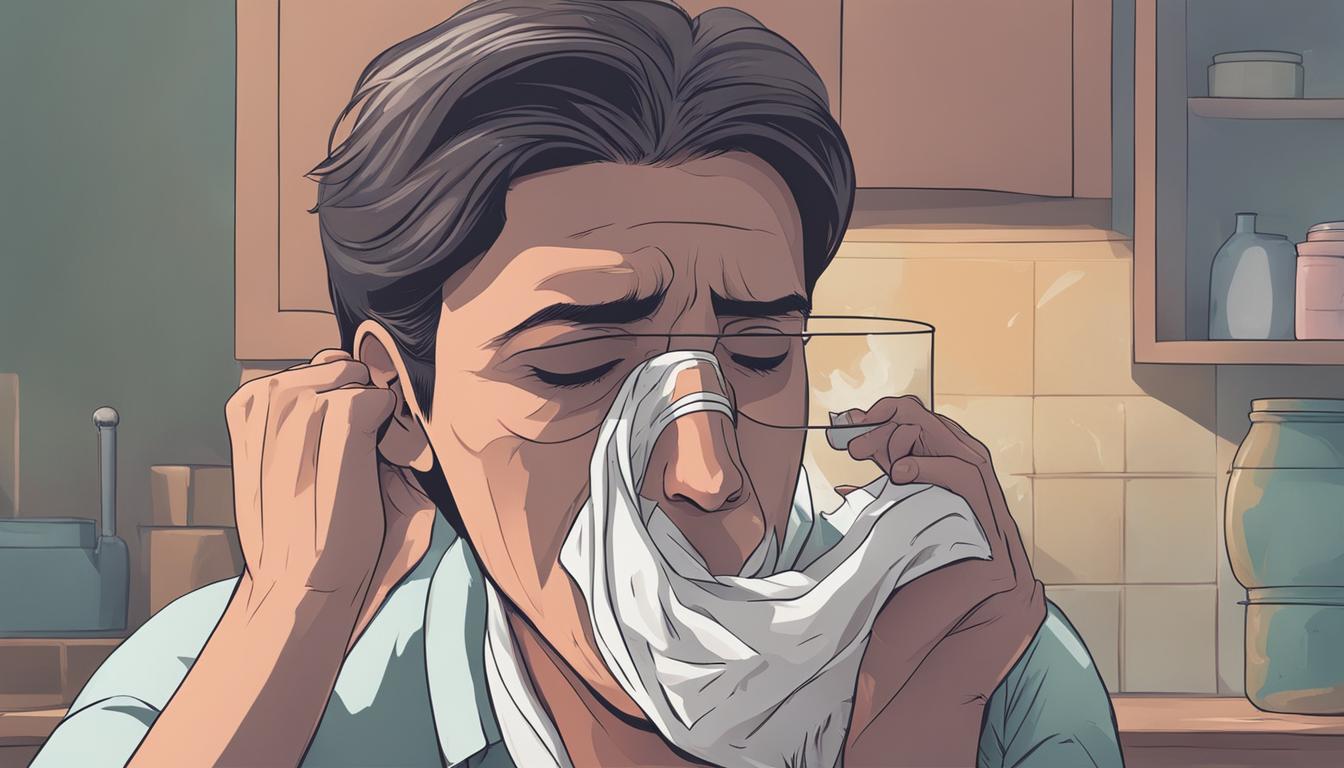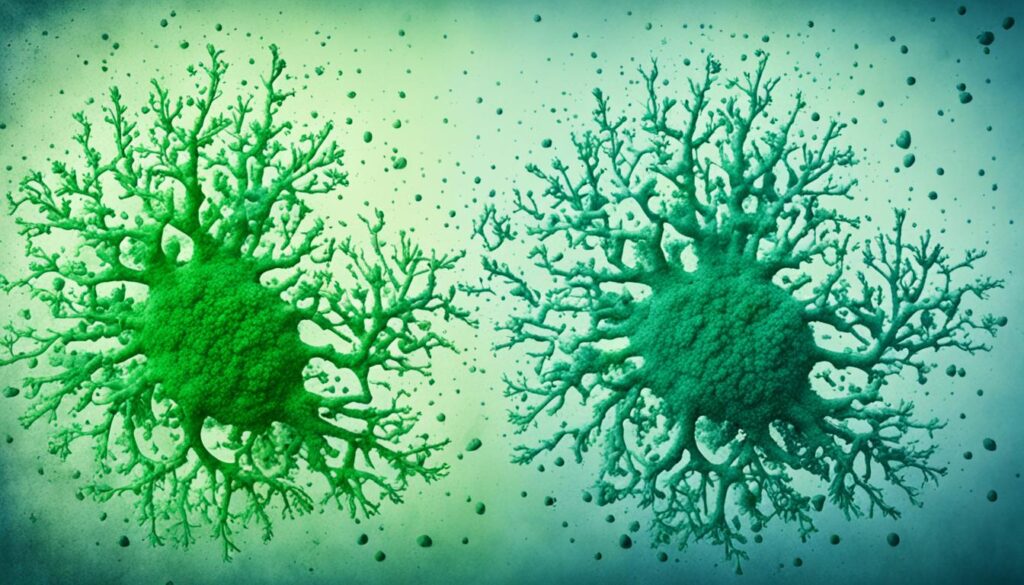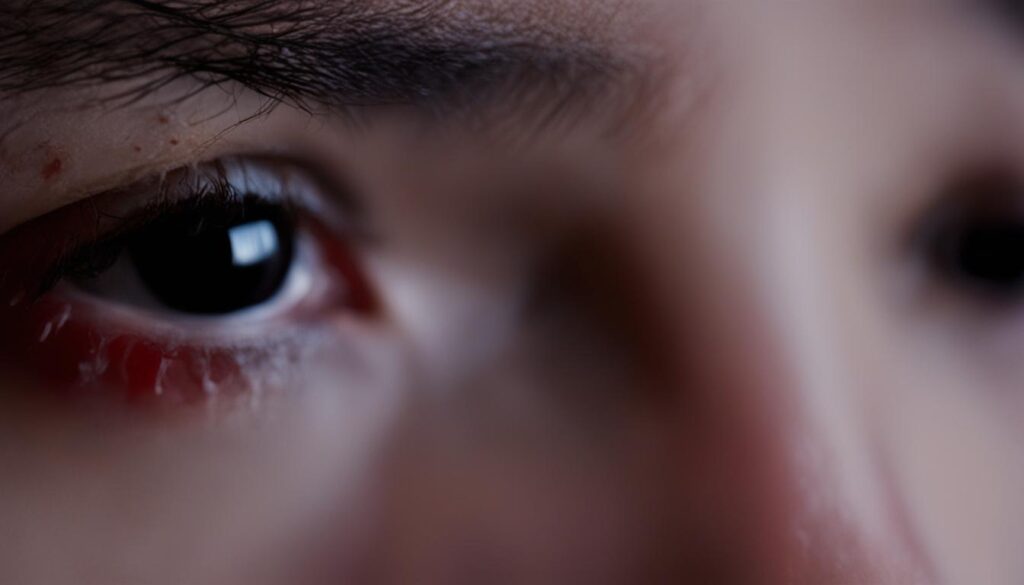
Mold Allergy Symptoms: Recognize the Signs
Welcome to our comprehensive guide on mold allergies. In this article, we will delve into the various signs and symptoms associated with mold allergies. Recognizing these symptoms is crucial for addressing indoor mold exposure effectively. We will explore respiratory issues, skin rashes, and other indicators of mold allergies to provide you with a comprehensive understanding.
Key Takeaways:
- Understanding mold allergy symptoms is essential for managing indoor mold exposure.
- Respiratory symptoms, such as sinus issues and mold-induced asthma, are common indicators of mold allergies.
- Skin rashes and allergic reactions can occur as a response to mold allergens.
- Mold exposure can have a significant impact on overall health, particularly respiratory health.
- Mold allergies can manifest in various environments, both indoors and outdoors, so recognizing the symptoms in different settings is important.
Respiratory Symptoms Related to Mold Allergies
Mold allergies often lead to various respiratory symptoms that can affect the overall well-being of individuals. In this section, we will delve into specific conditions associated with mold allergies, including sinus issues caused by mold, respiratory symptoms experienced due to mold allergy, signs of mold-induced asthma, and the body’s reaction to mold spores.
One common respiratory symptom of mold allergies is sinus issues. When exposed to mold spores, individuals may experience congestion, stuffiness, and pressure in the sinuses. This can lead to discomfort and difficulty in breathing, causing significant disruption to one’s daily life and overall health.
Furthermore, respiratory symptoms are a prominent indicator of mold allergy. These symptoms can include coughing, wheezing, shortness of breath, and chest tightness. When individuals with mold sensitivity come into contact with mold spores, their immune systems may overreact, triggering these respiratory symptoms.
For some individuals, mold-induced asthma may develop as a result of prolonged exposure to mold allergens. This condition is characterized by recurring episodes of asthma symptoms, such as coughing, wheezing, and difficulty breathing, triggered by exposure to mold spores. Proper identification of these signs is crucial for effective management and treatment of mold-induced asthma.
The body’s reaction to mold spores plays a significant role in determining the severity of respiratory symptoms. When mold spores are inhaled, the immune system responds by releasing chemicals that cause inflammation in the respiratory system. This inflammatory response can lead to a range of symptoms, such as nasal congestion, sneezing, and throat irritation.
Recognizing these respiratory symptoms related to mold allergies is vital for early detection and appropriate treatment. By understanding the specific signs and reactions, individuals can take proactive measures to minimize exposure to mold and seek medical advice to alleviate their symptoms.
| Respiratory Symptoms Related to Mold Allergies | Symptoms |
|---|---|
| Sinus issues from mold | Congestion, stuffiness, pressure in the sinuses |
| Respiratory symptoms mold allergy | Coughing, wheezing, shortness of breath, chest tightness |
| Mold-induced asthma signs | Recurring episodes of asthma symptoms (coughing, wheezing, difficulty breathing) |
| Mold spore reaction | Inflammatory response in the respiratory system (nasal congestion, sneezing, throat irritation) |
Skin Rash and Allergic Reactions to Mold
Mold allergies can also result in skin rashes and other allergic reactions. Identifying these skin-related symptoms is essential for addressing mold allergies effectively. Let’s explore some common mold allergy rash symptoms, signs of sensitivity to mold, and how the body reacts to mold allergens.
Common Mold Allergy Rash Symptoms
If you have a mold allergy, you may experience various skin-related symptoms. These can include:
- Rashes: Mold allergy rashes often appear as red, itchy, and inflamed patches on the skin.
- Hives: Raised, itchy welts or hives may develop as an allergic reaction to mold.
- Swelling: Mold allergies can cause swelling in the affected areas, leading to discomfort.
If you notice any of these mold allergy rash symptoms, it is important to seek medical advice for proper diagnosis and treatment.
Signs of Sensitivity to Mold
Sensitivity to mold can manifest in various ways. Some common signs include:
- Itchy or Irritated Skin: Sensitivity to mold may cause persistent itching or irritation on the skin.
- Dryness and Flaking: Dry, flaky skin can occur as a result of mold sensitivity.
- Burning or Stinging Sensation: People with mold sensitivity may experience a burning or stinging sensation upon contact with mold.
If you experience these signs of sensitivity, it is advisable to minimize your exposure to mold and consult with a healthcare professional.
How the Body Reacts to Mold Allergens
When exposed to mold allergens, the body initiates an allergic reaction. This reaction can trigger various responses, including skin-related symptoms. The immune system releases histamines, which can cause itching, redness, and swelling in the skin.
It is important to note that the severity and specific symptoms of mold allergy rashes may vary from person to person. Consulting with an allergist or dermatologist is crucial for accurate diagnosis and a personalized treatment plan.
Table: Comparing Mold Allergy Rash Symptoms and Sensitivity Signs
| Mold Allergy Rash Symptoms | Sensitivity Signs |
|---|---|
| Rashes | Itchy or Irritated Skin |
| Hives | Dryness and Flaking |
| Swelling | Burning or Stinging Sensation |
Effects of Mold Exposure on Overall Health
Mold exposure can have a significant impact on overall health. When individuals are exposed to mold, especially in high concentrations or over extended periods, it can lead to various health issues, particularly affecting the respiratory system.
Respiratory Symptoms and Mold Allergy:
One of the primary health concerns associated with mold exposure is the exacerbation of existing mold allergy symptoms. For individuals already sensitized to mold, exposure can trigger respiratory symptoms, such as:
- Coughing
- Sneezing
- Wheezing
- Shortness of breath
These symptoms can vary in severity depending on the individual’s sensitivity to mold and the concentration of mold spores in the environment.
Development of Sinus Issues:
In addition to respiratory symptoms, mold exposure can also contribute to the development of sinus issues. The inhalation of mold spores can irritate the nasal passages and sinus cavities, leading to:
- Chronic sinus congestion
- Recurring sinus infections
- Facial pressure and pain
- Post-nasal drip
These sinus issues can significantly impact an individual’s quality of life and may require medical intervention for effective management.
It’s important to note that the effects of mold exposure on overall health can vary depending on factors such as the type of mold, duration of exposure, and individual susceptibility. If you suspect mold exposure and are experiencing respiratory symptoms or sinus issues, it’s crucial to seek professional assistance to assess and address the situation.
Preventing Mold Exposure
Mold exposure can be minimized by taking proactive measures to prevent mold growth and ensure a healthy living environment. Here are some tips to help prevent mold:
- Keep humidity levels in check by using dehumidifiers or air conditioners.
- Address water leaks and moisture issues promptly.
- Ensure proper ventilation in bathrooms, kitchens, and other areas prone to high humidity.
- Clean and dry any water-damaged areas within 24-48 hours.
- Regularly clean and inspect areas susceptible to mold growth, such as basements, attics, and crawl spaces.
- Use mold-resistant products when renovating or building.
By following these preventive measures, you can reduce the risk of mold exposure and promote a healthier living environment.
It is essential to address any signs of mold growth promptly and efficiently to safeguard your health. Mold inspection and remediation experts like Fix Mold Miami can provide professional assistance in dealing with mold-related issues effectively. Call Fix Mold Miami at 305-465-6653 to ensure your living space is mold-free.

Recognizing Mold Allergy Symptoms in Different Environments
Mold allergies can occur in various environments, both indoor and outdoor. It’s important to be able to recognize the signs and symptoms of mold allergies to take appropriate measures and minimize further exposure. This section provides insights into identifying mold allergy symptoms in different settings, including common signs of mold allergies, signs of mold sensitivity, and allergic reactions due to mold exposure.
Common Signs of Mold Allergies
Mold allergies can manifest in various ways, with symptoms often resembling those of other allergies. Some common mold allergy symptoms include:
- Nasal congestion and runny nose
- Sneezing
- Coughing
- Itchy, watery eyes
- Headaches or migraines

Signs of Mold Sensitivity
In addition to the typical allergy symptoms, individuals with mold sensitivity may experience more severe reactions. These signs can include:
- Shortness of breath or difficulty breathing
- Wheezing or chest tightness
- Increased asthma attacks
- Frequent respiratory infections
Allergic Reactions Due to Mold Exposure
Mold allergens can trigger allergic reactions in susceptible individuals. These reactions can range from mild to severe and may include:
- Skin rashes or hives
- Itchy skin
- Swelling of the face, lips, or throat
- Difficulty swallowing or speaking
- Anaphylaxis (a severe, life-threatening allergic reaction)
By understanding these symptoms in different environments, individuals can take appropriate measures to address mold allergies and avoid further exposure.
Expert Quote:
“Recognizing mold allergy symptoms is crucial in managing and minimizing exposure. By identifying the signs of mold allergies in various environments, individuals can take timely action to protect their health.” – Dr. Lisa Adams, Allergy Specialist
| Environment | Symptoms |
|---|---|
| Indoor |
|
| Outdoor |
|
Conclusion
In conclusion, recognizing the signs and symptoms of mold allergies is crucial for managing and addressing indoor mold exposures. By understanding the respiratory symptoms, skin reactions, and overall health effects associated with mold allergies, individuals can take proactive steps to minimize exposure and seek appropriate treatment.
If you suspect mold allergies, it is important to consult professionals like Fix Mold Miami, Florida’s Highest Rated In Mold Assessments, Prevention, and Remediation service. With their expertise and experience, they can provide expert assistance in dealing with mold allergies.
Contact Fix Mold Miami at 305-465-6653 for a thorough assessment and effective solutions to your mold allergy concerns. Don’t let mold allergies compromise your health and well-being.
FAQ
What are the common signs and symptoms of mold allergies?
Mold allergy symptoms can vary but often include respiratory issues such as coughing, sneezing, and wheezing. Some individuals may also experience a runny or stuffed nose, itchy or watery eyes, and throat irritation. Skin rashes and allergic reactions can also occur.
How does mold exposure affect respiratory health?
Mold exposure can lead to respiratory symptoms such as sinus issues, including congestion, postnasal drip, and sinus infections. It can also trigger or worsen asthma symptoms, such as coughing, chest tightness, shortness of breath, and wheezing.
What are the signs of mold-induced asthma?
Signs of mold-induced asthma can include recurrent episodes of coughing, wheezing, chest tightness, and shortness of breath. These symptoms may be more pronounced after exposure to mold or in environments with high mold spore concentrations.
How does the body react to mold spores?
When exposed to mold spores, the immune system can trigger an allergic reaction. This can manifest as respiratory symptoms, skin rashes, or other allergic responses. The severity of the reaction can vary depending on individual sensitivity and the level of exposure.
What are the common symptoms of mold allergy rashes?
Mold allergy rashes may appear as red, itchy, or inflamed patches on the skin. These rashes can vary in size and may be accompanied by other allergic symptoms such as sneezing or watery eyes. It is important to consult a healthcare professional for proper diagnosis and treatment.
How does mold exposure affect overall health?
Mold exposure can have various effects on overall health, particularly respiratory health. It can worsen existing mold allergy symptoms, leading to persistent respiratory issues and increased susceptibility to sinus problems. Long-term exposure may also contribute to the development of respiratory infections.
How can I recognize mold allergy symptoms in different environments?
Mold allergy symptoms can occur in both indoor and outdoor environments. Common signs include respiratory issues, such as nasal congestion and coughing, skin rashes or hives, and allergic reactions such as sneezing or itchy eyes. If you experience these symptoms in multiple settings, it may indicate mold sensitivity.




